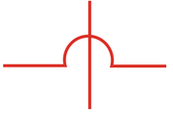|
I just wanted to pass along a few more resources which provide helpful information on "what" Synthesizers are and "how" the various components can be used.
Before I do that, I want to mention something I haven't heard anyone talk about… "Patch Cables" and, specifically, "how many" Patch Cables should you buy? There is no mathematical formula to this question. However, the rule-of-thumb would be "more is better". My very loose guideline for "how many" to buy would be:
Again, this is not a locked-in-stone way of approaching this. Yes, you can count the "Patch Points" (Cable-connection "holes" / "sockets") on each Module, and buy THAT MANY Cables, but that doesn't really work. In most cases, buying that many Cables would simply give you a LOT more Cables than your Synthesizer would ever be able to use.
Right now, we have 61-Patch Cables… BUT, combined, our 3 Synthesizers (ARP 2600, Behringer Neutron and a partially completed Eurorack Synth) contain 280-Patch Points. So, of course, we still have "Patch Cables" on our "buy more Eurorack items" list.
Patch Cable Length In a previous Post, I included a link to a "helpful tips" video by Robin Vincent. Here's that link: www.youtube.com/watch?v=l7LFURMEs8Q One of the things he learned, when performing Live with his Eurorack Synthesizer, is that he used short Cables whenever possible. The downside to this, he discovered, was that these Cables not only blocked the Modules they crossed (which they always do) but their tightness made it difficult for him to easily get his fingers through to the Knobs and Switches. Instead, it may sometimes be a good idea to use longer Cables and have them droop down and away from most of the Modules you'll be using in that Patch. Patch Cable Colors When I took Synthesizer Lessons in the 70s, Patch Cables were only available in "gray". (That's all "I" saw, anyway.) Today, there are LOTS of colors to choose from and there are 2 types of Synthesists, regarding which colors to buy:
This really comes down to "personal preference". For "us", even though Sylvia loves "Purple", we do our best to select as many different colors for each Patch as we can. When using a single color for an entire Patch, it can be continually frustrating, when you have to keep following and re-finding where each Cable goes, just to tweak something "quickly".
It's "sometimes" possible to use one color for "Modulation" (Envelopes, LFOs, etc.) and another color for "Audio". Let's say "Red" for Modulation and "Green" for Audio. However, there are 2 problems with this approach:
Synthesizer Resources Here are a few articles and videos where you can find a lot of helpful information on understanding Synthesizers (in no particular order): This article is titled: "What are CV, Gate and Triggers, and how do they relate to semi-modular synthesis?" www.musicradar.com/how-to/what-are-cv-gate-and-triggers-and-how-do-they-relate-to-semi-modular-synthesis The following article is titled: "Synth Terminology And Basics for Beginners". It covers:
Here's the link to that article: ask.audio/articles/synth-terminology-and-basics-for-beginners Here's the link to a Robin Vincent video titled: "Molten Modular 15 - Discovering oscillators with the Make Noise STO". www.youtube.com/watch?v=LUrtCf5i7ng Here's another good video by Robin Vincent. This one's titled: "Molten Modular 24 - Discovering Envelopes featuring TINRS Edgecutter". www.youtube.com/watch?v=2KOP1HqNbtY Here's Robin Vincent's main YouTube Channel: www.youtube.com/user/MoltenMusicTech/videos Modular Grid: The best place to go for "all things Eurorack related". www.modulargrid.net/e/modules/browser?SearchName=&SearchVendor=&SearchFunction=&SearchSecondaryfunction=&SearchTe=&SearchTemethod=max&SearchBuildtype=&SearchLifecycle=&SearchSet=&SearchMarketplace=&SearchIsmodeled=0&SearchShowothers=0&SearchShow1u=0&order=newest&direction=asc Of course there are LOTS of other sources of information online. Even with all the information and links I've provided here, there are still a few facets of Synthesizers which were not mentioned in the above articles and videos, such as:
0 Comments
In June, Sylvia and I traded-in our "Roland System-1m" ($600) for the "Behringer Neutron" ($300). It finally arrived last week.
There's a very good Review of the Neutron over at SonicState. Here's the link: sonicstate.com/news/2018/04/05/sonic-lab-behringer-neutron-analog-desktop-semi-modular-review/ Because I learned Synthesizers the "old school" way, with "Patch Charts", I wanted to be sure there was one available. The User's Manual does have a handy Patch Chart on page 27 but I fine-tuned it just a bit for our purposes. I have included it below for anyone to Download.
If you've never used a Patch Chart, there are no real "rules" of how to draw-out and explain a Patch. So, for what it's worth, these are a few things I've learned over the years on how to write-out a Patch so you'll understand it years from now:
|
Note:
If you'd like to "Follow", "Like" or "Comment" on our Blogs, please visit our mirrored Blogsite: Archives
November 2018
Categories
All
|
||||||||||||||
Infinity


 RSS Feed
RSS Feed
